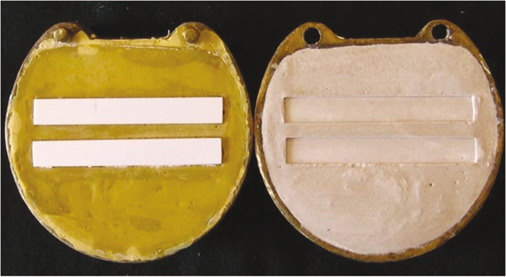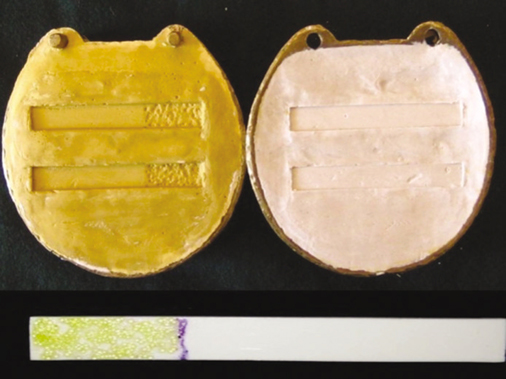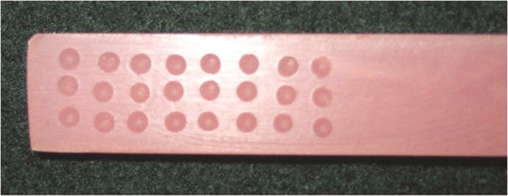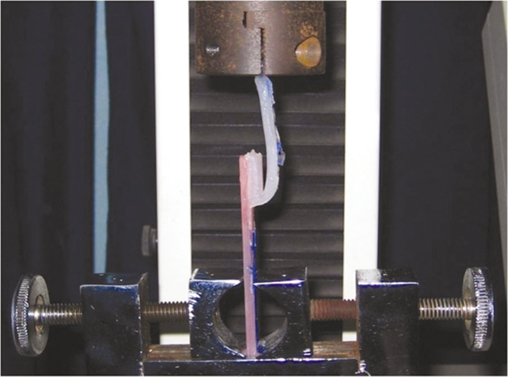J Adv Prosthodont.
2012 Aug;4(3):121-126. 10.4047/jap.2012.4.3.121.
Evaluation of bonding efficiency between facial silicone and acrylic resin using different bonding agents and surface alterations
- Affiliations
-
- 1Rangoonwala Dental College, Pune, Maharashtra, India.
- 2Department of Prosthodontics, SDM College of Dental Sciences and Hospital, Karnataka, India. drsatyabodh@yahoo.co.in
- KMID: 2176405
- DOI: http://doi.org/10.4047/jap.2012.4.3.121
Abstract
- PURPOSE
The aim of the study was to evaluate the effect of 3 silicone primers and 3 surface characterization of acrylic resin surface on bond strength between silicone elastomer and acrylic resin.
MATERIALS AND METHODS
96 Cosmesil silicones bonded to heat-curing acrylic resin were fabricated with the dimension of 75 x 10 x 3 mm. The 3 primers used in this study were G611 platinum primer, A-330 Gold platinum primer, and cyanoacrylates resin. Specimens without primer were used as control. The 3 types of surface characterization done were retentive holes with 1.5 mm in diameter and 0.5 mm deep, retentive beads of 0.6 mm diameter and the third type which was plain without any characterization. The specimens were then checked for bond strength by subjecting them to 180degrees peel test on a universal testing machine. The obtained results were then subjected to statistical analysis using 2-way ANOVA and Scheffe multiple post hoc procedures. The statistical significance was set at 5% level of significance.
RESULTS
The maximum bond strength was seen for samples in which A-330G primer was used followed by G611 primer. The control group showed the minimum bond strength. Surface characterization of retentive holes increased the bond strength considerably as compared to retentive beads and samples without any surface characterization.
CONCLUSION
Within the limitations of the study, A-330G primer was more compatible with Cosmesil M511 silicone and has better bonding of Cosmesil to acrylic resin. Retentive holes made on acrylic surface increased the bond strength considerably than those without any surface characterization.
Keyword
MeSH Terms
Figure
Reference
-
1. Hatamleh MM, Watts DC. Bonding of maxillofacial silicone elastomers to an acrylic substrate. Dent Mater. 2010. 26:387–395.2. Polyzois GL, Frangou MJ. Bonding of silicone prosthetic elastomers to three different denture resins. Int J Prosthodont. 2002. 15:535–538.3. Taft RM, Cameron SM, Knudson RC, Runyan DA. The effect of primers and surface characteristics on the adhesion-in-peel force of silicone elastomers bonded to resin materials. J Prosthet Dent. 1996. 76:515–518.4. Minami H, Suzuki S, Ohashi H, Kurashige H, Tanaka T. Effect of surface treatment on the bonding of an autopolymerizing soft denture liner to a denture base resin. Int J Prosthodont. 2004. 17:297–301.5. Mutluay MM, Ruyter IE. Evaluation of bond strength of soft relining materials to denture base polymers. Dent Mater. 2007. 23:1373–1381.6. Singer MT, Mitchell DL, Pelleu GB Jr. Effect of primers on the bond strength of silicone elastomers and polyurethane. J Prosthet Dent. 1988. 60:602–605.7. Wang R, Collard SM, Lemon J. Adhesion of silicone to polyurethane in maxillofacial prostheses. Int J Prosthodont. 1994. 7:43–49.8. Polyzois GL. A comparison of microwave and dry-heat curing methods on the bond strength of silicone facial materials applied to acrylic resin. J Prosthodont. 1996. 5:101–104.9. Frangou MJ, Polyzois GL, Tarantili PA, Andreopoulos AG. Bonding of silicone extra-oral elastomers to acrylic resin: the effect of primer composition. Eur J Prosthodont Restor Dent. 2003. 11:115–118.10. Amin WM, Fletcher AM, Ritchie GM. The nature of the interface between polymethyl methacrylate denture base materials and soft lining materials. J Dent. 1981. 9:336–346.11. Qudah S, Harrison A, Huggett R. Soft lining materials in prosthetic dentistry: a review. Int J Prosthodont. 1990. 3:477–483.12. al-Athel MS, Jagger RG. Effect of test method on the bond strength of a silicone resilient denture lining material. J Prosthet Dent. 1996. 76:535–540.13. Craig RG, Gibbons P. Properties of resilient denture liners. J Am Dent Assoc. 1961. 63:382–390.14. Jagger RG, al-Athel MS, Jagger DC, Vowles RW. Some variables influencing the bond strength between PMMA and a silicone denture lining material. Int J Prosthodont. 2002. 15:55–58.
- Full Text Links
- Actions
-
Cited
- CITED
-
- Close
- Share
- Similar articles
-
- An Experimental Study of the Effects of Cementing Stage and the Presence of Synovial Fluid and Physiologic Saline at the Interface upon the Tensile Bonding Strength of Acrylic Bone Cement
- Bond strength according to the adhesive type and the distance between enamel surface and resin base in indirect bonding
- THE EFFECT OF SURFACE TREATMENT ON FRACTURE STRENGTH OF DENTAL CERAMICS
- The effect of bonded resin surface area on the detachment force of lingual bonded fixed retainers: An in vitro study
- Self-adhesion of low-viscosity composites to dentin surface





